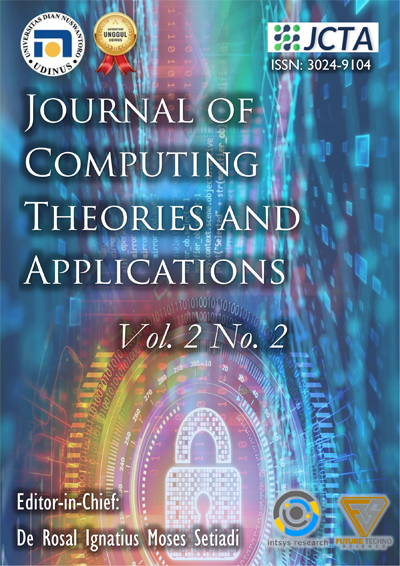Comprehensive Review of Security Problems in Mobile Robotic Assistant Systems: Issues, Solutions, and Challenges
DOI:
https://doi.org/10.62411/jcta.11408Abstract
Nowadays, robots in the modern world are playing an important and increasingly popular role. MRA (Mobile Robotic Assistant) is a type of mobile robot designed to support humans in many different fields, helping to improve efficiency and safety in daily activities, work, or medical treatment. The number of MRAs is increasing and diverse in function, in addition to the ability to collect and process data, MRAs also have the ability to physically interact with users. Therefore, security is one of the important issues to improve the safety and effective operation of MRA. In this paper, through a comprehensive literature review and detailed analysis of the prominent MRA security attacks in recent years (based on criteria such as: attack targets, technologies used, impact level, feasibility, and contribution to addressing overall MRA security issues), a systematic classification by MRA activity fields is conducted. Security attacks, threats, and vulnerabilities are examined from various perspectives, such as hardware attacks or network/system-level attacks, operating systems/application software. Additionally, corresponding security solutions are proposed, compared, and evaluated to enhance MRA security. The paper also addresses challenges and suggests open research directions for the future.References
M. T. Nguyen and H. R. Boveiri, “Energy-efficient sensing in robotic networks,” Measurement, vol. 158, p. 107708, Jul. 2020, doi: 10.1016/j.measurement.2020.107708.
E. Fosch-Villaronga and T. Mahler, “Cybersecurity, safety and robots: Strengthening the link between cybersecurity and safety in the context of care robots,” Comput. Law Secur. Rev., vol. 41, p. 105528, Jul. 2021, doi: 10.1016/j.clsr.2021.105528.
M. D. Nguyen, M. T. Nguyen, T. C. Vu, T. M. Ta, Q. A. Tran, and D. T. Nguyen, “A Comprehensive Study on Applications of Blockchain in Wireless Sensor Networks for Security Purposes,” J. Comput. Theor. Appl., vol. 2, no. 1, pp. 102–117, Jul. 2024, doi: 10.62411/jcta.10486.
S. Jain and R. Doriya, “Security Issues and Solutions in Cloud Robotics: A Survey,” in Next Generation Computing Technologies on Computational Intelligence, Springer Singapore, 2019, pp. 64–76. doi: 10.1007/978-981-15-1718-1_6.
J. Petit and S. E. Shladover, “Potential Cyberattacks on Automated Vehicles,” IEEE Trans. Intell. Transp. Syst., vol. 16, no. 2, pp. 1–11, 2014, doi: 10.1109/TITS.2014.2342271.
A. Khalid, P. Kirisci, Z. H. Khan, Z. Ghrairi, K.-D. Thoben, and J. Pannek, “Security framework for industrial collaborative robotic cyber-physical systems,” Comput. Ind., vol. 97, pp. 132–145, May 2018, doi: 10.1016/j.compind.2018.02.009.
R. Doczi et al., “Increasing ROS 1.x communication security for medical surgery robot,” in 2016 IEEE International Conference on Systems, Man, and Cybernetics (SMC), Oct. 2016, pp. 004444–004449. doi: 10.1109/SMC.2016.7844931.
M. Staffa, G. Mazzeo, and L. Sgaglione, “Hardening ROS via Hardware-assisted Trusted Execution Environment,” in 2018 27th IEEE International Symposium on Robot and Human Interactive Communication (RO-MAN), Aug. 2018, pp. 491–494. doi: 10.1109/ROMAN.2018.8525696.
M. Pogliani, D. Quarta, M. Polino, M. Vittone, F. Maggi, and S. Zanero, “Security of controlled manufacturing systems in the connected factory: the case of industrial robots,” J. Comput. Virol. Hacking Tech., vol. 15, no. 3, pp. 161–175, Sep. 2019, doi: 10.1007/s11416-019-00329-8.
J.-P. Yaacoub, H. Noura, O. Salman, and A. Chehab, “Security analysis of drones systems: Attacks, limitations, and recommenda-tions,” Internet of Things, vol. 11, p. 100218, Sep. 2020, doi: 10.1016/j.iot.2020.100218.
M. T. Nguyen, H. M. La, and K. A. Teague, “Compressive and collaborative mobile sensing for scalar field mapping in robotic networks,” in 2015 53rd Annual Allerton Conference on Communication, Control, and Computing (Allerton), Sep. 2015, pp. 873–880. doi: 10.1109/ALLERTON.2015.7447098.
D. L. T. Tran, H. T. Do, H. T. Tran, T. Hoang, and M. T. Nguyen, “A Design and Implement of Fuzzy Controller for Taking-off and Landing for Unmanned Aerial Vehicles,” in Advances in Engineering Research and Application, 2023, pp. 13–22. doi: 10.1007/978-3-031-22200-9_2.
H. T. Do, H. T. Hua, H. T. T. Nguyen, M. T. Nguyen, and H. T. Tran, “Cooperative Tracking Framework for Multiple Unmanned Aerial Vehicles (UAVs),” in Advances in Engineering Research and Application, 2022, pp. 276–285. doi: 10.1007/978-3-030-92574-1_29.
V. C. Thanh, N. N. A. Quan, T. Le Thang Dong, T. T. Hoang, and M. T. Nguyen, “Fusion of Inertial and Magnetic Sensors for Autonomous Vehicle Navigation and Freight in Distinctive Environment,” in Advances in Engineering Research and Application, 2022, pp. 431–439. doi: 10.1007/978-3-030-92574-1_45.
A. Q. Pham, H. M. La, K. T. La, and M. T. Nguyen, “A Magnetic Wheeled Robot for Steel Bridge Inspection,” in Advances in En-gineering Research and Application, 2020, pp. 11–17. doi: 10.1007/978-3-030-37497-6_2.
R. A. Beasley, “Medical Robots: Current Systems and Research Directions,” J. Robot., vol. 2012, pp. 1–14, 2012, doi: 10.1155/2012/401613.
H. T. Tran, D. L. T. Tran, and M. T. Nguyen, “Design of a robotic system to assist in the treatment of severe COVID‐19 patients,” Adv. Control Appl., vol. 6, no. 1, Mar. 2024, doi: 10.1002/adc2.193.
H. T. Tran et al., “Field programmable gate array based moving object tracking system for robot navigation,” Bull. Electr. Eng. In-formatics, vol. 12, no. 2, pp. 771–781, Apr. 2023, doi: 10.11591/eei.v12i2.4538.
Đ. Q. Long, N. H. Công, D. P. Tuấn, N. Q. Vịnh, and N. T. Minh, “A Comprehensive Study of Mobile Robot Navigation and Obstacle Avoidance Schemes,” TNU J. Sci. Technol., vol. 228, no. 14, pp. 302–312, Nov. 2023, doi: 10.34238/tnu-jst.8978.
M. T. Nguyen, K. A. Teague, and S. Bui, “Compressive wireless mobile sensing for data collection in sensor networks,” in 2016 International Conference on Advanced Technologies for Communications (ATC), Oct. 2016, pp. 437–441. doi: 10.1109/ATC.2016.7764822.
H. T. Tran et al., “A novel design of a smart interactive guiding robot for busy airports,” Int. J. Smart Sens. Intell. Syst., vol. 15, no. 1, Jan. 2022, doi: 10.2478/ijssis-2022-0017.
H. Noura, T. Hatoum, O. Salman, J.-P. Yaacoub, and A. Chehab, “LoRaWAN security survey: Issues, threats and possible mitigation techniques,” Internet of Things, vol. 12, p. 100303, Dec. 2020, doi: 10.1016/j.iot.2020.100303.
K. Ahmad Yousef, A. AlMajali, S. Ghalyon, W. Dweik, and B. Mohd, “Analyzing Cyber-Physical Threats on Robotic Platforms,” Sensors, vol. 18, no. 5, p. 1643, May 2018, doi: 10.3390/s18051643.
G. W. Clark, M. V. Doran, and T. R. Andel, “Cybersecurity issues in robotics,” in 2017 IEEE Conference on Cognitive and Computational Aspects of Situation Management (CogSIMA), Mar. 2017, pp. 1–5. doi: 10.1109/COGSIMA.2017.7929597.
J. Block, “A laws of war review of contemporary land-based missile defence system ‘Iron Dome,’” Sci. Mil., vol. 45, no. 2, Dec. 2017, doi: 10.5787/45-2-1207.
H. T. Tran, D. T. Tran, M. T. Nguyen, and T. C. Vu, “Intelligent mobile robot for contagious disease treatments in hospitals,” MethodsX, vol. 13, p. 102941, Dec. 2024, doi: 10.1016/j.mex.2024.102941.
N. Campagna, V. Castiglia, R. Miceli, F. Viola, A. Busacca, and M. T. Nguyen, “Hybrid Energy Storage Systems: A Brief Overview,” in Advances in Engineering Research and Application, 2023, pp. 573–579. doi: 10.1007/978-3-031-22200-9_62.
M. T. Nguyen, “An energy-efficient framework for multimedia data routing in Internet of Things (IoTs),” EAI Endorsed Trans. Ind. Networks Intell. Syst., vol. 6, no. 19, p. 159120, Jun. 2019, doi: 10.4108/eai.13-6-2019.159120.
M. Tehranipoor and F. Koushanfar, “A Survey of Hardware Trojan Taxonomy and Detection,” IEEE Des. Test Comput., vol. 27, no. 1, pp. 10–25, Jan. 2010, doi: 10.1109/MDT.2010.7.
X. Wang, T. Mal-Sarkar, A. Krishna, S. Narasimhan, and S. Bhunia, “Software exploitable hardware Trojans in embedded proces-sor,” in 2012 IEEE International Symposium on Defect and Fault Tolerance in VLSI and Nanotechnology Systems (DFT), Oct. 2012, pp. 55–58. doi: 10.1109/DFT.2012.6378199.
S. Bhunia and M. M. Tehranipoor, Eds., The Hardware Trojan War. Cham: Springer International Publishing, 2018. doi: 10.1007/978-3-319-68511-3.
M. Safta, P. Svasta, M. Dima, A. Marghescu, and M.-N. Costiuc, “Design and setup of Power Analysis attacks,” in 2016 IEEE 22nd International Symposium for Design and Technology in Electronic Packaging (SIITME), Oct. 2016, pp. 110–113. doi: 10.1109/SIITME.2016.7777256.
Y. Hayashi et al., “Efficient Evaluation of EM Radiation Associated With Information Leakage From Cryptographic Devices,” IEEE Trans. Electromagn. Compat., vol. 55, no. 3, pp. 555–563, Jun. 2013, doi: 10.1109/TEMC.2012.2222890.
M. T. Nguyen, C. V. Nguyen, and H. N. Nguyen, “Visualization-based monitoring in early warning systems with wireless sensor networks,” Indones. J. Electr. Eng. Comput. Sci., vol. 31, no. 1, p. 281, Jul. 2023, doi: 10.11591/ijeecs.v31.i1.pp281-289.
T. Vuong, A. Filippoupolitis, G. Loukas, and D. Gan, “Physical indicators of cyber attacks against a rescue robot,” in 2014 IEEE International Conference on Pervasive Computing and Communication Workshops (PERCOM WORKSHOPS), Mar. 2014, pp. 338–343. doi: 10.1109/PerComW.2014.6815228.
R. E. Navas, H. Le Bouder, N. Cuppens, F. Cuppens, and G. Z. Papadopoulos, “Demo: Do Not Trust Your Neighbors! A Small IoT Platform Illustrating a Man-in-the-Middle Attack,” in Ad-hoc, Mobile, and Wireless Networks, 2018, pp. 120–125. doi: 10.1007/978-3-030-00247-3_11.
P. Ferguson and D. Senie, “Network Ingress Filtering: Defeating Denial of Service Attacks which employ IP Source Address Spoofing,” Jan. 1998. doi: 10.17487/rfc2267.
H. Elmiligi, F. Gebali, and M. W. El-Kharashi, “Multi-dimensional analysis of embedded systems security,” Microprocess. Microsyst., vol. 41, pp. 29–36, Mar. 2016, doi: 10.1016/j.micpro.2015.12.005.
H. Kabir, M.-L. Tham, and Y. C. Chang, “Internet of robotic things for mobile robots: Concepts, technologies, challenges, applica-tions, and future directions,” Digit. Commun. Networks, vol. 9, no. 6, pp. 1265–1290, Dec. 2023, doi: 10.1016/j.dcan.2023.05.006.
M. Benmalek, “Ransomware on cyber-physical systems: Taxonomies, case studies, security gaps, and open challenges,” Internet Things Cyber-Physical Syst., vol. 4, pp. 186–202, 2024, doi: 10.1016/j.iotcps.2023.12.001.
K. Cottrell, D. B. Bose, H. Shahriar, and A. Rahman, “An Empirical Study of Vulnerabilities in Robotics,” in 2021 IEEE 45th Annual Computers, Software, and Applications Conference (COMPSAC), Jul. 2021, pp. 735–744. doi: 10.1109/COMPSAC51774.2021.00105.
M. H. Khan and M. Ali Shah, “Survey on security threats of smartphones in Internet of Things,” in 2016 22nd International Conference on Automation and Computing (ICAC), Sep. 2016, pp. 560–566. doi: 10.1109/IConAC.2016.7604979.
G. S. Kc, A. D. Keromytis, and V. Prevelakis, “Countering code-injection attacks with instruction-set randomization,” in Proceedings of the 10th ACM conference on Computer and communications security, Oct. 2003, pp. 272–280. doi: 10.1145/948109.948146.
H. Shahbaznezhad, F. Kolini, and M. Rashidirad, “Employees’ Behavior in Phishing Attacks: What Individual, Organizational, and Technological Factors Matter?,” J. Comput. Inf. Syst., vol. 61, no. 6, pp. 539–550, Nov. 2021, doi: 10.1080/08874417.2020.1812134.
T. Eisenbarth, S. Kumar, C. Paar, A. Poschmann, and L. Uhsadel, “A Survey of Lightweight-Cryptography Implementations,” IEEE Des. Test Comput., vol. 24, no. 6, pp. 522–533, Nov. 2007, doi: 10.1109/MDT.2007.178.
C. De Cannière, O. Dunkelman, and M. Knežević, “KATAN and KTANTAN — A Family of Small and Efficient Hard-ware-Oriented Block Ciphers,” in Cryptographic Hardware and Embedded Systems - CHES 2009, 2009, pp. 272–288. doi: 10.1007/978-3-642-04138-9_20.
Z. Gong, S. Nikova, and Y. W. Law, “KLEIN: A New Family of Lightweight Block Ciphers,” in RFID. Security and Privacy, 2012, pp. 1–18. doi: 10.1007/978-3-642-25286-0_1.
C. H. Lim and T. Korkishko, “mCrypton – A Lightweight Block Cipher for Security of Low-Cost RFID Tags and Sensors,” in Information Security Applications, 2006, pp. 243–258. doi: 10.1007/11604938_19.
K. Shibutani, T. Isobe, H. Hiwatari, A. Mitsuda, T. Akishita, and T. Shirai, “Piccolo: An Ultra-Lightweight Blockcipher,” in Cryp-tographic Hardware and Embedded Systems – CHES 2011, 2011, pp. 342–357. doi: 10.1007/978-3-642-23951-9_23.
A. Bogdanov et al., “PRESENT: An Ultra-Lightweight Block Cipher,” in Cryptographic Hardware and Embedded Systems - CHES 2007, Berlin, Heidelberg: Springer Berlin Heidelberg, 2007, pp. 450–466. doi: 10.1007/978-3-540-74735-2_31.
E. Bilhan, R. Padakanti, and A. S. Mundra, “Tamper detection,” 2021 [Online]. Available: https://patents.justia.com/patent/11132659
V. N. Cherukuri, S. Balakrishnan, and C. L. Rao, “Tamper detection techniques,” 2024 [Online]. Available: https://patents.justia.com/patent/11893146
R. Sion, “Anti-tamper system,” 2018 [Online]. Available: https://patents.justia.com/patent/10007811
J. A. Busby, J. R. Dangler, M. J. Fisher, and D. C. Long, “Tamper-respondent assembly with interconnect characteristic(s) obscuring circuit layout,” 2020 [Online]. Available: https://patents.justia.com/patent/10575398
M. Razaghi, “Secure electronic circuitry with tamper detection,” 2023 [Online]. Available: https://patents.justia.com/patent/11681833
A. R. Hasan and R. Rezaian, “Method and apparatus for tamper detection,” 2018 [Online]. Available: https://patents.justia.com/patent/9898909
R. Falk, “Tamper protection device for protecting a field device against tampering,” 2018 [Online]. Available: https://patents.justia.com/patent/9858446
S. Jog, V. Bhatnagar, T. Chinchore, D. Chinchalkar, and R. Chidrawar, “Design and Implementation of Stainless Steel EMI Com-pliant Enclosure for Wireless Communication System,” in 2018 Fourth International Conference on Computing Communication Control and Automation (ICCUBEA), Aug. 2018, pp. 1–5. doi: 10.1109/ICCUBEA.2018.8697398.
I. Frieslaar and B. Irwin, “Developing an Electromagnetic Noise Generator to Protect a Raspberry PI from Side Channel Analysis,” SAIEE Africa Res. J., vol. 109, no. 2, pp. 85–101, Jun. 2018, doi: 10.23919/SAIEE.2018.8531950.
G. Mazzeo and M. Staffa, “TROS: Protecting Humanoids ROS from Privileged Attackers,” Int. J. Soc. Robot., vol. 12, no. 3, pp. 827–841, Jul. 2020, doi: 10.1007/s12369-019-00581-4.
T. Suzaki, K. Minematsu, S. Morioka, and E. Kobayashi, “TWINE: A Lightweight Block Cipher for Multiple Platforms,” in Selected Areas in Cryptography, 2013, pp. 339–354. doi: 10.1007/978-3-642-35999-6_22.
H. Yap, K. Khoo, A. Poschmann, and M. Henricksen, “EPCBC - A Block Cipher Suitable for Electronic Product Code Encryption,” in Cryptology and Network Security, 2011, pp. 76–97. doi: 10.1007/978-3-642-25513-7_7.
A. Hussein, I. H. Elhajj, A. Chehab, and A. Kayssi, “Securing Diameter: Comparing TLS, DTLS, and IPSec,” in 2016 IEEE Inter-national Multidisciplinary Conference on Engineering Technology (IMCET), Nov. 2016, pp. 1–8. doi: 10.1109/IMCET.2016.7777417.
A. Fagiolini, M. Pellinacci, G. Valenti, G. Dini, and A. Bicchi, “Consensus-based Distributed Intrusion Detection for Multi-Robot Systems,” in 2008 IEEE International Conference on Robotics and Automation, May 2008, pp. 120–127. doi: 10.1109/ROBOT.2008.4543196.
Dit-Yan Yeung and C. Chow, “Parzen-window network intrusion detectors,” in Object recognition supported by user interaction for service robots, 2002, vol. 4, pp. 385–388. doi: 10.1109/ICPR.2002.1047476.
G. Vigna, W. Robertson, V. Kher, and R. A. Kemmerer, “A stateful intrusion detection system for world-wide web servers,” in 19th Annual Computer Security Applications Conference, 2003. Proceedings., 2003, pp. 34–43. doi: 10.1109/CSAC.2003.1254308.
M. T. Nguyen and K. A. Teague, “Neighborhood based data collection in Wireless Sensor Networks employing Compressive Sensing,” in 2014 International Conference on Advanced Technologies for Communications (ATC 2014), Oct. 2014, pp. 198–203. doi: 10.1109/ATC.2014.7043383.
M. Gudadhe, P. Prasad, and L. Kapil Wankhade, “A new data mining based network Intrusion Detection model,” in 2010 International Conference on Computer and Communication Technology (ICCCT), Sep. 2010, pp. 731–735. doi: 10.1109/ICCCT.2010.5640375.
H. Om and A. Kundu, “A hybrid system for reducing the false alarm rate of anomaly intrusion detection system,” in 2012 1st In-ternational Conference on Recent Advances in Information Technology (RAIT), Mar. 2012, pp. 131–136. doi: 10.1109/RAIT.2012.6194493.
R. Sean, I. A. Ken, and others, “Ros-immunity: Integrated approach for the security of ros-enabled robotic systems,” TechRciv. 2023. doi: 10.36227/techrxiv.13013336.
Y. Zhou, T. A. Mazzuchi, and S. Sarkani, “M-AdaBoost-A based ensemble system for network intrusion detection,” Expert Syst. Appl., vol. 162, p. 113864, Dec. 2020, doi: 10.1016/j.eswa.2020.113864.
A. Gorbenko and V. Popov, “Abnormal Behavioral Pattern Detection in Closed-Loop Robotic Systems for Zero-Day Deceptive Threats,” in 2020 International Conference on Industrial Engineering, Applications and Manufacturing (ICIEAM), May 2020, pp. 1–6. doi: 10.1109/ICIEAM48468.2020.9112054.
A. Almalawi et al., “Add-On Anomaly Threshold Technique for Improving Unsupervised Intrusion Detection on SCADA Data,” Electronics, vol. 9, no. 6, p. 1017, Jun. 2020, doi: 10.3390/electronics9061017.
C. Irvene, D. Formby, S. Litchfield, and R. Beyah, “HoneyBot: A Honeypot for Robotic Systems,” Proc. IEEE, vol. 106, no. 1, pp. 61–70, Jan. 2018, doi: 10.1109/JPROC.2017.2748421.
C. Hecker and B. Hay, “Automated Honeynet Deployment for Dynamic Network Environment,” in 2013 46th Hawaii International Conference on System Sciences, Jan. 2013, pp. 4880–4889. doi: 10.1109/HICSS.2013.110.
N. Ilg, P. Duplys, D. Sisejkovic, and M. Menth, “A survey of contemporary open-source honeypots, frameworks, and tools,” J. Netw. Comput. Appl., vol. 220, p. 103737, Nov. 2023, doi: 10.1016/j.jnca.2023.103737.
N. Bhagat and B. Arora, “Intrusion Detection Using Honeypots,” in 2018 Fifth International Conference on Parallel, Distributed and Grid Computing (PDGC), Dec. 2018, pp. 412–417. doi: 10.1109/PDGC.2018.8745761.
V. Strobel, E. Castelló Ferrer, and M. Dorigo, “Blockchain Technology Secures Robot Swarms: A Comparison of Consensus Pro-tocols and Their Resilience to Byzantine Robots,” Front. Robot. AI, vol. 7, May 2020, doi: 10.3389/frobt.2020.00054.
M. Nguyen, C. Nguyen, and H. T. Tran, “A Framework of Deploying Blockchain in Wireless Sensor Networks,” EAI Endorsed Trans. Ind. Networks Intell. Syst., vol. 9, no. 32, p. e3, Aug. 2022, doi: 10.4108/eetinis.v9i32.1125.
A. Terra, H. Riaz, K. Raizer, A. Hata, and R. Inam, “Safety vs. Efficiency: AI-Based Risk Mitigation in Collaborative Robotics,” in 2020 6th International Conference on Control, Automation and Robotics (ICCAR), Apr. 2020, pp. 151–160. doi: 10.1109/ICCAR49639.2020.9108037.
C. Wang, Y. C. Tok, R. Poolat, S. Chattopadhyay, and M. R. Elara, “How to secure autonomous mobile robots? An approach with fuzzing, detection and mitigation,” J. Syst. Archit., vol. 112, p. 101838, Jan. 2021, doi: 10.1016/j.sysarc.2020.101838.
M. T. Nguyen, H. M. La, and K. A. Teague, “Collaborative and Compressed Mobile Sensing for Data Collection in Distributed Robotic Networks,” IEEE Trans. Control Netw. Syst., vol. 5, no. 4, pp. 1729–1740, Dec. 2018, doi: 10.1109/TCNS.2017.2754364.
B. Breiling, B. Dieber, and P. Schartner, “Secure communication for the robot operating system,” in 2017 Annual IEEE International Systems Conference (SysCon), Apr. 2017, pp. 1–6. doi: 10.1109/SYSCON.2017.7934755.
S. Hussaini, “Cyber Security in Cloud Using Blowfish Encryption,” Int. J. Inf. Technol., vol. 6, no. 5, 2020, [Online]. Available: https://api.semanticscholar.org/CorpusID:224430049
A. O. Elfaki et al., “Revolutionizing Social Robotics: A Cloud-Based Framework for Enhancing the Intelligence and Autonomy of Social Robots,” Robotics, vol. 12, no. 2, p. 48, Mar. 2023, doi: 10.3390/robotics12020048.
S. Chavhan and R. Doriya, “Secured Map Building using Elliptic Curve Integrated Encryption Scheme and Kerberos for Cloud-based Robots,” in 2020 Fourth International Conference on Computing Methodologies and Communication (ICCMC), Mar. 2020, pp. 157–164. doi: 10.1109/ICCMC48092.2020.ICCMC-00032.
A. Bezemskij, G. Loukas, D. Gan, and R. J. Anthony, “Detecting Cyber-Physical Threats in an Autonomous Robotic Vehicle Using Bayesian Networks,” in 2017 IEEE International Conference on Internet of Things (iThings) and IEEE Green Computing and Communications (GreenCom) and IEEE Cyber, Physical and Social Computing (CPSCom) and IEEE Smart Data (SmartData), Jun. 2017, pp. 98–103. doi: 10.1109/iThings-GreenCom-CPSCom-SmartData.2017.20.
Feng Zhang, Shijie Zhou, Zhiguang Qin, and Jinde Liu, “Honeypot: a supplemented active defense system for network security,” in Proceedings of the 8th International Scientific and Practical Conference of Students, Post-graduates and Young Scientists. Modern Technique and Technologies. MTT’2002 (Cat. No.02EX550), pp. 231–235. doi: 10.1109/PDCAT.2003.1236295.
S. Rivera and R. State, “Securing Robots: An Integrated Approach for Security Challenges and Monitoring for the Robotic Oper-ating System (ROS),” in 2021 IFIP/IEEE International Symposium on Integrated Network Management (IM), 2021. [Online]. Available: https://ieeexplore.ieee.org/abstract/document/9463965
S. Rivera, A. K. Iannillo, S. Lagraa, C. Joly, and R. State, “ROS-FM: Fast Monitoring for the Robotic Operating System(ROS),” in 2020 25th International Conference on Engineering of Complex Computer Systems (ICECCS), Oct. 2020, pp. 187–196. doi: 10.1109/ICECCS51672.2020.00029.
S. Rivera, S. Lagraa, C. Nita-Rotaru, S. Becker, and R. State, “ROS-Defender: SDN-Based Security Policy Enforcement for Robotic Applications,” in 2019 IEEE Security and Privacy Workshops (SPW), May 2019, pp. 114–119. doi: 10.1109/SPW.2019.00030.
M. A. Chauhan, M. A. Babar, and S. Grainger, “Designing a Security Platform for Collaborating Autonomous Systems - An Expe-rience Report,” in 2021 IEEE 18th International Conference on Software Architecture Companion (ICSA-C), Mar. 2021, pp. 1–7. doi: 10.1109/ICSA-C52384.2021.00018.
J. Fernandez, B. Allen, P. Thulasiraman, and B. Bingham, “Performance Study of the Robot Operating System 2 with QoS and Cyber Security Settings,” in 2020 IEEE International Systems Conference (SysCon), Aug. 2020, pp. 1–6. doi: 10.1109/SysCon47679.2020.9275872.
R. Amini, R. Sulaiman, and A. Hadi, “CryptoROS: A Secure Communication Architecture for ROS-Based Applications,” Int. J. Adv. Comput. Sci. Appl., vol. 9, no. 10, 2018, doi: 10.14569/IJACSA.2018.091022.
R. White, G. Caiazza, H. Christensen, and A. Cortesi, “SROS1: Using and Developing Secure ROS1 Systems,” in Robot Operating System (ROS), 2019, pp. 373–405. doi: 10.1007/978-3-319-91590-6_11.
J. Balsa-Comerón, Á. M. Guerrero-Higueras, F. J. Rodríguez-Lera, C. Fernández-Llamas, and V. Matellán-Olivera, “Cybersecurity in Autonomous Systems: Hardening ROS Using Encrypted Communications and Semantic Rules,” in ROBOT 2017: Third Iberian Robotics Conference, 2018, pp. 67–78. doi: 10.1007/978-3-319-70836-2_6.
B. Breiling, B. Dieber, M. Pinzger, and S. Rass, “A Cryptography-Powered Infrastructure to Ensure the Integrity of Robot Work-flows,” J. Cybersecurity Priv., vol. 1, no. 1, pp. 93–118, Jan. 2021, doi: 10.3390/jcp1010006.
T. C. Vu, M. T. Nguyen, V. T. Nguyen, and Q. C. Le, “Approach New Framework of Compressive Sensing Based Secret Sharing in Wireless Sensor Network: Theory and Applications,” in Advances in Information and Communication Technology, 2024, pp. 26–34. doi: 10.1007/978-3-031-50818-9_4.
S. Zaman, S. Raheel, T. Jamil, and M. Zalisham, “A Text based Authentication Scheme for Improving Security of Textual Pass-words,” Int. J. Adv. Comput. Sci. Appl., vol. 8, no. 7, 2017, doi: 10.14569/IJACSA.2017.080771.
J. Kang, D. Nyang, and K. Lee, “Two-factor face authentication using matrix permutation transformation and a user password,” Inf. Sci. (Ny)., vol. 269, pp. 1–20, Jun. 2014, doi: 10.1016/j.ins.2014.02.011.
D. Carrillo-Torres, J. A. Pérez-Díaz, J. A. Cantoral-Ceballos, and C. Vargas-Rosales, “A Novel Multifactor Authentication Algo-rithm Based on Image Recognition and User Established Relations,” Appl. Sci., vol. 13, no. 3, p. 1374, Jan. 2023, doi: 10.3390/app13031374.
S. Haas, T. Ulz, and C. Steger, “Secured Offline Authentication on Industrial Mobile Robots Using Biometric Data,” in RoboCup 2017: Robot World Cup XXI, 2018, pp. 143–155. doi: 10.1007/978-3-030-00308-1_12.
A. Khalifa, A. A. Abdelrahman, D. Strazdas, J. Hintz, T. Hempel, and A. Al-Hamadi, “Face Recognition and Tracking Framework for Human–Robot Interaction,” Appl. Sci., vol. 12, no. 11, p. 5568, May 2022, doi: 10.3390/app12115568.
Downloads
Published
How to Cite
Issue
Section
License
Copyright (c) 2024 Long Q. Dinh, Dung T. Nguyen, Thang C. Vu, Tao V. Nguyen, Minh T. Nguyen

This work is licensed under a Creative Commons Attribution 4.0 International License.















